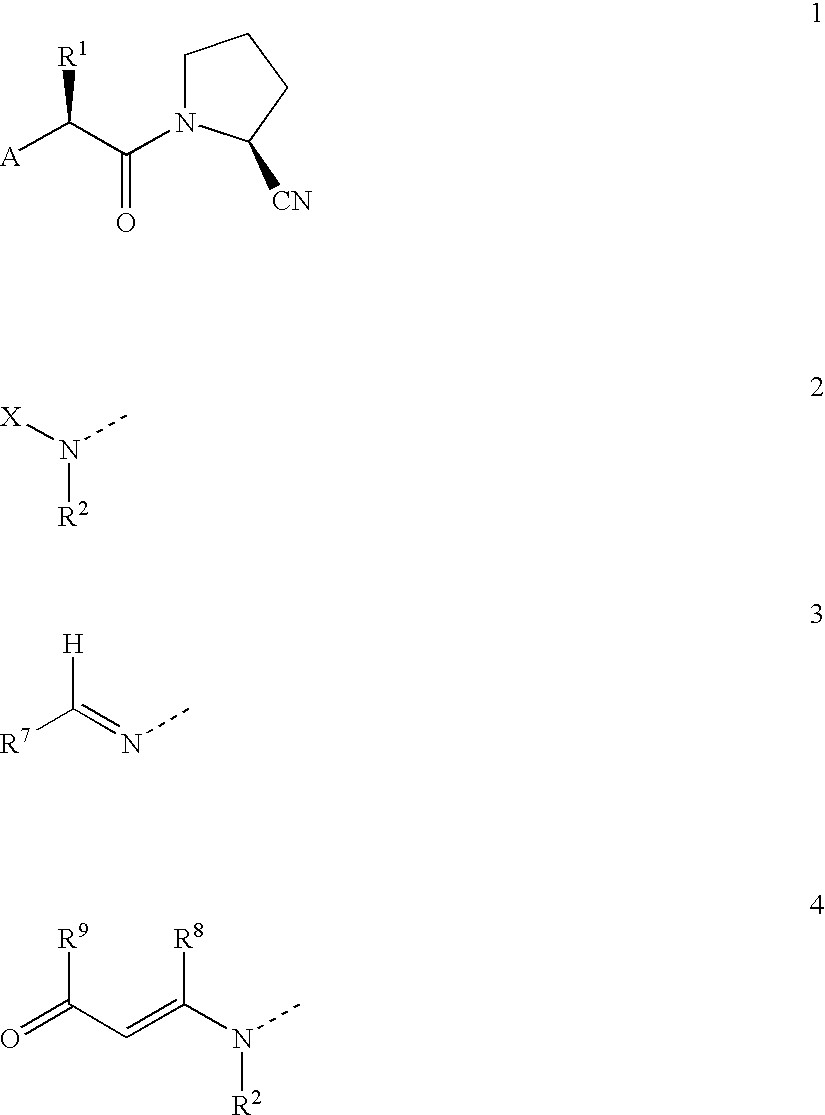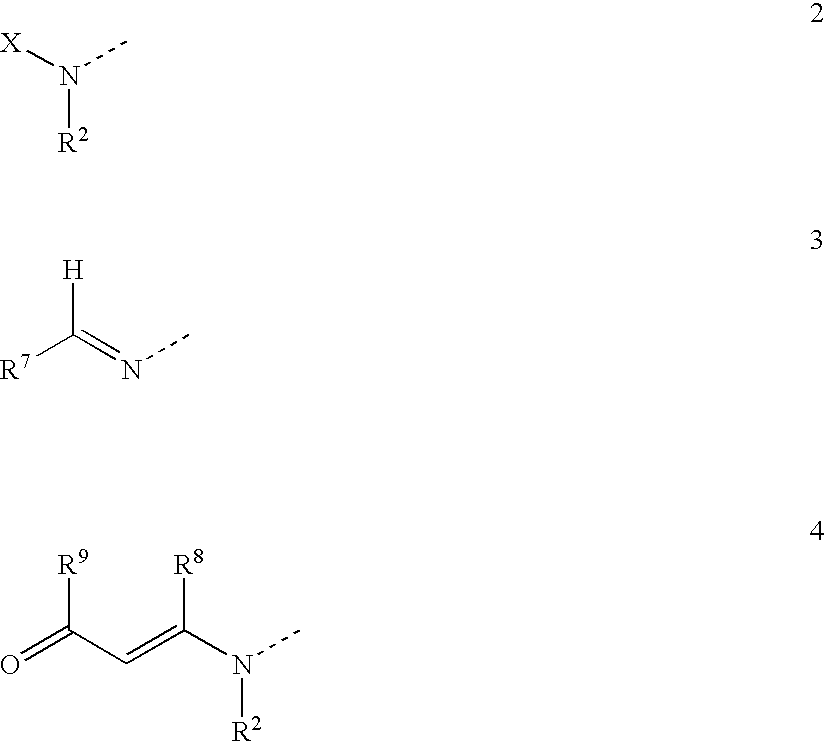Antidiabetic agents
a technology of antidiabetic agents and compound compounds, applied in the field of antidiabetic agents, can solve the problems of insufficient potency of compound compounds to be viable therapeutic agents, difficulty in preparing and storing materials of adequate quality,
- Summary
- Abstract
- Description
- Claims
- Application Information
AI Technical Summary
Problems solved by technology
Method used
Image
Examples
example 1
(2S)-1-((2′S)-2′-(1″-Acetoxyethoxycarbonylamino)-3′,3′-dimethyl-butanoyl)pyrrolidine-2-carbonitrile
[0075]
[0076]A solution of (2S)-1-((2′S)-2′-amino-3′,3′-dimethylbutanoyl)pyrrolidine-2-carbonitrile hydrochloride (180 mg, 0.73 mmol; prepared according to Jenkins et al., WO95 / 15309), α-acetoxyethyl p-nitrophenyl carbonate (220 mg, 0.82 mmol; prepared according to Alexander et al., J. Med. Chem. 31, 318, 1988) and triethylamine (90 mg, 0.90 mmol) in dichloromethane (25 ml) was stirred at room temperature for 18 hours. After this time the solvent was removed in vacuo and the residue was taken up in ethyl acetate (70 ml). This solution was washed with 0.3M KHSO4, sat. NaHCO3, water and brine, dried (Na2SO4) and evaporated. The residue was purified by flash chromatography (eluant EtOAc:Pet. Ether 60-80° C.; 3:7) yielding a white solid identified as the title compound (170 mg, 0.50 mmol, 68%).
[0077]MS:—ESI {M+H}+=340.2 1H NMR (CDCl3): δ 1.02, 1.03 (9H, 2×s), 1.42-1.46 (3H, m), 2.03, 2.05 (...
example 2
(2S)-1-(N′-(1″-Acetoxyethoxycarbonyl)isoleucyl)pyrrolidine-2-carbonitrile
[0078]
[0079]A solution of (2S)-1-(isoleucyl)pyrrolidine-2-carbonitrile hydrochloride (500 mg, 2.04 mmol; prepared according to Jenkins et al., WO95 / 15309), α-acetoxyethyl p-nitrophenyl carbonate (610 mg, 2.27 mmol; prepared according to Alexander et al., J. Med. Chem. 31, 318, 1988) and triethylamine (250 mg, 2.50 mmol) in dichloromethane (40 ml) was stirred at room temperature for 18 hours. After this time the solvent was removed in vacuo and the residue was taken up in ethyl acetate (70 ml). This solution was washed with 0.3M KHSO4, sat. NaHCO3, water and brine, dried (Na2SO4) and evaporated. The residue was purified by flash chromatography (eluant EtOAc:Pet. Ether 60-80° C.; 3:7) yielding a colourless oil identified as the title compound (480 mg, 1.42 mmol, 70%).
[0080]MS:—ESI {M+H}+=340.0 1H NMR (CDCl3): δ 0.86-0.89 (6H, m), 0.92-0.97 (1H, m), 1.41-1.45 (3H, m), 150-1.80 (2H, m), 2.02 (3H, d, J=5.2 Hz), 2.14...
example 3
(2S)-1-(N′-(Methoxycarbonyl)isoleucyl)pyrrolidine-2-carbonitrile
[0081]
[0082]A solution of (2S)-1-(isoleucyl)pyrrolidine-2-carbonitrile hydrochloride (300 mg, 1.22 mmol; prepared according to Jenkins et al., WO95 / 15309), methyl chloroformate (125 mg, 1.3 mmol) and triethylamine (150 mg, 1.50 mmol) in dichloromethane (40 ml) was stirred at room temperature for 18 hours. After this time the solvent was removed in vacuo and the residue was taken up in ethyl acetate (70 ml). This solution was washed with 0.3M KHSO4, sat. NaHCO3, water and brine, dried (Na2SO4) and evaporated. The residue was purified by flash chromatography (EtOAc:Pet. Ether 60-80° C.; 4:6) yielding a colourless oil identified as the title compound (310 mg, 1.16 mmol, 95%).
[0083]MS:—ESI {M+H}+=268.2 1H NMR (CDCl3): δ 0.85-0.95 (6H, m), 1.10-1.25 (1H, m), 1.54-1.77 (2H, m), 2.11-2.26 (4H, m), 3.62 (3H, s), 3.66-3.79 (2H, m), 4.21 (1H, t, J=9.2 Hz), 4.74-4.78 (1H, m), 5.30 (1H, d, J=9.1 Hz) ppm.
PUM
| Property | Measurement | Unit |
|---|---|---|
| optical isomers | aaaaa | aaaaa |
| pharmaceutical composition | aaaaa | aaaaa |
| covalent | aaaaa | aaaaa |
Abstract
Description
Claims
Application Information
 Login to View More
Login to View More - R&D
- Intellectual Property
- Life Sciences
- Materials
- Tech Scout
- Unparalleled Data Quality
- Higher Quality Content
- 60% Fewer Hallucinations
Browse by: Latest US Patents, China's latest patents, Technical Efficacy Thesaurus, Application Domain, Technology Topic, Popular Technical Reports.
© 2025 PatSnap. All rights reserved.Legal|Privacy policy|Modern Slavery Act Transparency Statement|Sitemap|About US| Contact US: help@patsnap.com



